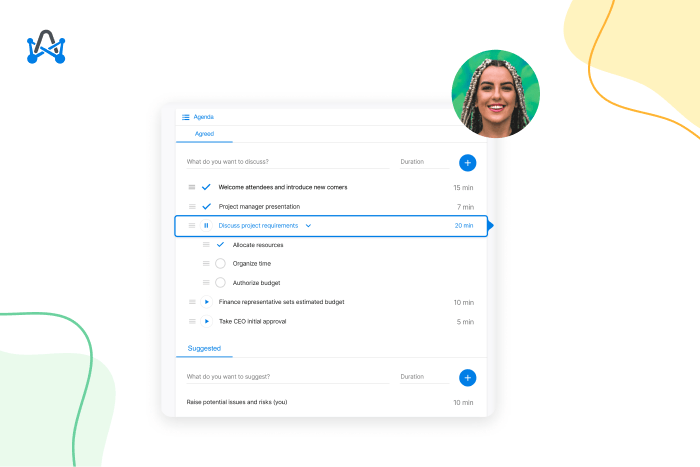April 4, 2022 · 7 min read
Succeed at Writing Effective Meeting Objectives

Mary Nour

"Start with the end in mind" is a great quote by Stephen Covey that can apply to almost everything, from manifesting good things to decluttering that disorganized room in your place.
And here's how this quote applies to the topic of effective meeting objectives: what answer you want your attendees to say when people ask them "so, what did you do at the meeting?" Once you decide on the answer, you're off to writing compelling meeting objectives.
Keep in mind that no matter what type of meeting you're scheduling, it's important to draft a set of meeting goals. And to get started, the list doesn't have to be big or complicated; just three to four bullet points will do it.
In this article, you'll get to explore several tips on writing effective goals and check out some examples.
Before diving into how to write excellent meeting goals, first, let's answer the following question.
What is the difference between meeting purpose and meeting objective?
The meeting purpose isn't as concrete and tangible as the meeting objective. Its aim is to set the general tone of the meeting. In contrary, the meeting objective is specific, measurable, and concise.
Example on meeting purpose and meeting objective
Purpose. Enhance integrations with our software.
Objective. Integrate three platforms over the course of three months.
Now that you know the difference between the two, the next step is to know what type of meeting you're going to schedule. To help you out, we've compiled a list of meeting types, and most probably, your meeting will fall into one of the following categories:
- Decision making
- Strategic planning
- Information sharing
- Status updates
- Goal setting
- Problem solving
- Crisis management
- Performance assessment
- Process improvement
- Training/workshops
- Brainstorming
- Consulting/soliciting feedback
- Task assignments
- Policy/procedure reviews
- Team building
Now, let's explore how you can write relevant meeting objectives/goals.
How to write meeting objectives?
1. As mentioned before, "start with the end in mind." To write effective meeting objectives, start by thinking about the answer you want your attendees to say when people ask them "so, what did you do at the meeting?"
2. Create a list of several goals you want to accomplish in the meeting. It shouldn't be long or complicated. These goals are not the agenda items or activities the meeting participants will be engaged in. Their purpose is to have a more high-level view focusing on your desired outcomes for the meeting. When you write down your goals, you'll easily omit those that are irrelevant.
3. Understand that creating excellent meeting objectives will take time and they shouldn't be prepared just before the meeting. To have concrete meeting objectives, share them with the meeting participants at least 24 hours before the meeting takes place. Ask the participants to review and identify any missing or unnecessary goals. This can help ensure that everyone is on the same page, save time, and increase engagement.
4. Write your objectives the SMART way. The SMART framework can be a great guide when writing meeting objectives. It is basically about writing Specific, Measurable, Achievable, Relevant, and Time-bound objectives. A SMART objective can be as follows:
S – Specific: Outline what is required in a clear statement. What outcome, by when. For example, increasing the website traffic by 10% within three months.
M – Measurable: You need to include a measure to enable your company to monitor progress and know when the objective has been achieved; in our example to increase website traffic, currently, we have 50 articles and we should work on increasing the number to 90, based on the statistics we've gathered. That's a measurable goal.
A – Achievable: You need a challenging goal, but it's important that it's not challenging to the point of failure. It must be achievable.
R – Relevant: The objective should be relevant to the company's broader goals, which is, in our example, to increase visibility and sale.
T – Time-bound: For an objective to be time-bound, it should have a timeline that defines the beginning and the end of the period in which the objective is measured. There's a start and end point, and we can measure the changes within the specified period. And everyone should agree on the purposed timeline.
5. Our minds always search for reasons/benefits. So, make sure when writing an objective to highlight its benefits. This will motivate your meeting participants to get the job done as fast as possible and will increase their engagement.
Meeting objectives examples
In this section, we've compiled examples on meeting objectives from different resources to inspire you to write your own.
1. Source: Indeed
Example 1
If you are meeting with your company's human resources manager to review applications you have received for a job opening, your aim may be to leave the meeting with a condensed list of candidates who you plan to interview. Here's an example of a meeting objective for this situation:
"The objective of this meeting is to narrow our pool of applicants down to the top three candidates best suited for this role and schedule in-person interviews with each of them early next week."
Example 2
If you are meeting with a client to discuss concepts for a marketing campaign, your goal may be to leave the meeting with a clear direction of which concept the client likes the best. An effective meeting objective for this situation can be:
"Our goal for this session is to present three different concepts and identify which one the client would like us to implement for our next marketing campaign."
Example 3
If you are working on a large team project that involves multiple steps, you may choose to meet with your coworkers to determine how you can organize the project and delegate tasks. An effective meeting objective for this situation could be:
"The objective we are striving for today is to identify what steps we need to take in order to complete this project, assign the steps to individual members of our team, and set deadlines for the completion of each step."
2. Source: HBR
Board meeting:
- Provide Board input as Management formulates the new five-year strategy
- Agree on how much runway remains on the current core strategy
- Identify new strategies to potentially pursue
- Finalize the operating model for strategic governance
- Annual strategic planning process
- Long-term (five+ year) strategic oversight
- Agree on the topics and timing for additional Board input into the current planning cycle
Executive team meeting:
- Develop a list of growth opportunities for the team to further assess
- Begin to define select growth opportunities, including the future state description for each and potential measures of success
- Confirm the accountable executive and team leader for each opportunity
- Understand the timeline and activities over the next three months
Leadership conference:
- Establish the purpose and positioning of the Extended Leadership Team
- Impart a meaningful understanding of the company’s vision, mission, and strategy, including top priorities for the next three years
- Understand priority issues surfaced by attendees and develop potential solutions
- Align around next steps
3. Check out the meeting objectives of the following meetings we wrote about in our blog:
- Skip-level meeting objective: “With your help, I’ll gain invaluable feedback about your team and manager and the organization, so I can make informed decisions and work towards eliminating obstacles and offering you the help you need.”
- Standup meeting objective: To increase team commitment and coordinate efforts through knowing who is doing what, priorities versus what can wait, and what outstanding obstacles and questions need to be addressed.
- Status meeting objective: To communicate the project status across departments and acknowledge any roadblocks.
- Sales meeting objective: Assessing sales team endeavors and overall achievements.
More meeting agenda templates
You can find a list of other useful meetings agenda templates on our blog, which can guide you to hold effective meetings:
1. Team meeting
4. First meeting with new team
➕Extra Bonus. Make sure to send a thank you mail after the meeting is finished; it has a positive effect on attendees and enhances meeting productivity.
The bottom line
To sum up, effective meeting objectives are your gate to telling your meeting attendees that their time will not be wasted and having people look forward to your meetings. However, you may need to explore one more thing to level up your meetings and hold meetings that will grow your business. It's meeting management software.
Agile meeting management software, like adam.ai, go hand in hand with effective meeting objectives to help you kick off meetings that meet business needs faster.
From creating meeting agendas and easily assigning tasks to voting on recommendations, taking notes, and linking meetings if you are creating a series, all in an agile manner, don't miss the chance to explore what meeting management software can bring to the table.
And while there may be multiple meeting management solutions available, here is why adam.ai is the all-in-one meeting management platform you can trust:
- adam.ai is one of Atlassian Ventures' portfolio companies.
- In the meeting management software category on G2, adam.ai has been ranked a leader and a high performer for successive quarters in the past years.
- adam.ai has been included in the Forrester Report in the AI-enabled meeting technology landscape.
- adam.ai is trusted and used by powerful teams and organizations worldwide for all types of critical meetings, like board, committee, project management, and business development meetings.
- And most importantly, adam.ai integrates with your existing workflow, is SOC2 compliant, provides dedicated support and success, and has a free trial option.
Transform how you conduct critical meetings—From meticulous preparation to effective execution and insightful follow-up, adam.ai integrates comprehensive analytics, full customization, and intuitive interfaces with powerful meeting management tools.
Easy onboarding. Enterprise-grade security. 24/7 dedicated support.
Subscribe to adam.ai blog
Stay ahead with the latest insights—get our newest blog posts, tips, and updates sent straight to your inbox.